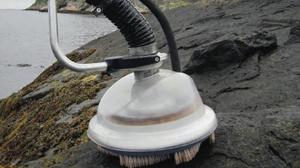DisastersSucking up oil spills is a cinch
Cleaning up oil spills is a time consuming, difficult process, but a novel approach uses a new kind of vacuum cleaner that blows bark or other absorbent material onto oil spills, and then sucks the material up again. The vacuum cleaner is four times more efficient in cleaning up after oil accidents than conventional techniques

MOSE at work // Source: gizmag.com
Cleaning up oil spills is a time consuming, difficult process, but a novel approach developed at the Norwegian University of Science and Technology (NTNU) uses a new kind of vacuum cleaner that blows bark or other absorbent material onto oil spills, and then sucks the material up again. The vacuum cleaner is four times more efficient in cleaning up after oil accidents than conventional techniques. It started with a simple assignment for master’s students in NTNU’s Department of Product Design: make something useful that employs air and electronics. Silje Rabben and three of her fellow students decided it was time to take oil cleanups out of the Stone Age, and developed the new kind of vacuum cleaner that speeds up oil spill cleanups.
The design has been so successful that the students founded a company, Kaliber Industrial Design, and are now looking for investors to help market their invention, the MOSE — or “Mechanical Oil spill Sanitation Equipment.”
The invention has already won a number of prestigious Scandinavian innovation awards, including DnB NOR’s Innovation Award for Mid-Norway, 2010; Tekna’s Innovation Award 2010; second place in the 2010 Venture Cup National Finals; and the best student idea in the 2010 Venture Cup competition.
Today’s oil spill cleanup technology usually involves the use of an absorbent material, such as bark or peat moss, to soak up the oil. Workers then have to remove the wet, heavy absorbent material, and the remaining oil residue may have to be scrubbed off the rocks.
“The oil vacuum cleaner automates what we currently do manually,” says Rabben. “It is common to use bark to absorb the oil. So we have also used it. But it is also possible to use peat moss or chemical absorbents.”
The vacuum cleaner currently weighs about 10 kilos, but the engineers are working to cut its weight to 5 kilos. The equipment will also be changed so that it can be folded up to be more compact.
The secret of the design, however, is all in the vacuum cleaner’s head. The machine first sprays bark or other absorbent material onto the spill. Rotating brushes in the head work the oil and the absorbent material together. When the oil and absorbent material are thoroughly mixed, the direction of the rotating brushes is reversed, enabling the bark to be sucked up into the equipment while the rocks are simultaneously scrubbed.
Leif Gunnar Smistad, a fire engineer and oil spill manager at Trondheim’s Fire and Rescue Service, says the advantage of the vacuum cleaner is that it is portable. Smistad helped develop the idea.
“Every day we spread bark on small oil spills from overfilled oil tanks or from car accidents. Then we use a broom, a shovel and a bucket to clean up. We’re very interested in mobile solutions that make these cleanups more effective,” Smistad says.
Company representatives participated in the recent Clean Gulf Training Event and Exhibition in Tampa, Florida, and then went to New Orleans to meet with authorities and companies who have been involved with the cleanup after the Macondo Deepwater Horizon accident.
“Naturally, there is a lot of focus on oil spills and cleanup work in the Gulf of Mexico after the Macondo accident,” Rabben says. “We just have to jump in.”
